Chapter 7: Awakening
In the picture below, I am not entirely clear what Los is doing. Interpretations vary. Some (il.e. Erdman) say he is aiming his hammer at the bricks; others(i.e. Damon) say his aim is at the sun. It seems to me more likely that he is aiming at the bricks, because to hit the sun effectively, to pound it into the opening, he would more naturally be standing up. If he is aiming at the bricks, then the corresponding text is that in which Los, with his "mighty Hammer" (73:32), knocks down the "rocky hardness" (73:23) of the "World of Opakness" (73:22) and "opens the Furnaces of affliction" (73:25) to free the souls of those who have been bound to "Eternal Death" (73:40).

As he peels away the bricks, the image is that of Los "the Remover of Limits & the Resurrection of the Dead" (.73:30). It is as though the bricks were the shell of an egg, to be broken so that the spirit within may step out.
On the other hand, if he is aiming at the sun, he is alluding to an earlier stage of the process. In that case, the sun is not the spirit, but rather the "all the Kings & Nobles of the Earth & all their Glories" (73:38). It is the false barbed sun of Urizen, in other words. By pounding the kings and nobles into his furnace, he is surrounding them with the prophets, "to preserve them from Eternal Death" (73:40), a process which in the furnace succeeds in "dissipating the rocky forms of Death, by his thunderous Hammer (73:43). In either case, Blake is showing us the transforming power of Los's "furnaces of affliction.".
Another source of movement, as Jerusalem comes to a close, occurs after Gwendolen advises her sisters. Blake says, "To entice her Sisters away to Babylon...she closed her left hand and utter'd her Falsehood: Forgetting that Falsehood is prophetic, she hid her hand behind her, Upon her back behind her loins and thus utter'd her Deceit" (82:10-22). The deceit is a lie about Los, that he is plotting against them. Gwendolem hopes thereby to draw her sisters away from Los and toward Vala's Babylon. Blake has a depiction of this scene, showing a young woman's left hand behind her back talking to eleven other ladies, i.e. the other eleven daughters of Vala. But in the illustration Gwendolen is doing something with her right hand that is not in the text: she is pointing to a piece of writing in mirror-writing (Plate 81):

To read what it says, let us first make the writing horizontal:

Then if we reverse right and left in the image, we get the following:
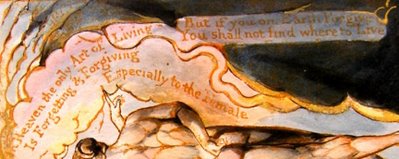
"In Heaven the only Art of Living/ Is Forgetting & Forgiving./ Especially to the Female. But if you on Earth Forgive,/ You shall not find where to Live."
Besides the reference to Gwendolen uttering a falsehood, another thing that makes these statements suspect is that they are in the same position as Vala was in a similar scene earlier, tempting Jerusalem.
Yet the commentators insist--rightly, I think--that Blake does not mean the statement at which Gwendolen is pointing to be taken as false. The falsehood is in Gwendolen's left hand. Blake is having her right hand do something her left hand apparently does not know about. The statement about "Forgetting & Forgiving" is something Blake's Jesus could have said. Blake made this clear at the beginning of the book: "The Spirit of Jesus is continual forgiveness of Sin" (Plate 3, no line number).
But what are we to make of the other statements in the bubble: "Especially to the Female" and the one, "If you on Earth forgive, you shall not find where to live"?
"Especially to the female" might mean either "It is especially important to forgive the female" or "It is especially important that the female forgive."
For more on this issue, let us look at another Plate with aphorisms on it. At the top are two angels grieving, with a globe between them. On it are the words. "Continually Building, Coninually Decaying, because of Love and Jealousy" (Plate 72, top):

In other words, jealousy destroys what love builds up. Then at the bottom of the page is another piece of mirror-writing, which I have flipped so that it is readable (Plate 72, bottom).

"Women the Comforters of Men become the Tormenters & Punishers." Here the message is clear: women are the ones who need to forgive rather than punish. On the other hand, maybe this is the snake speaking. But why this focus on women?
Perhaps it says something about Blake's home life. Blake likely wasn't the easiest person to live with. We already know about his "foolish pride." Maybe his wife was getting upset about his foolishness. We also have had reason to suspect his jealousy, that like Los he might have tried to shut his wife up to have just for himself.
Another possibility is that at some point in his marriage his attention might have gone to another woman, even if he had not acted upon his desire. One of Blake's earliest biographers, who interviewed people who knew the couple, makes a significant comment: "There had been stormy times...when both were young; discord by no means trifling...But with the cause (jealousy on her side, not wholly unprovoked) the strife had ceased also (Gilcrest, 1863, as quoted in Bentley, The Stranger from Paradise, 2001, p. 144).
Along these lines, a few of the "Songs of Experience," which he had engraved in 1794, suggest discomfort with the marriage bond. One is "The Clod and the Pebble"

Another example is the poem "My Pretty Rose Tree":
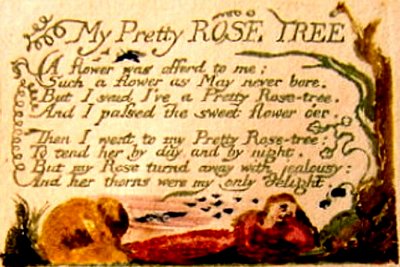
Whatever actually happened, Blake might have been experiencing his wife's reaction to him as punishment and torment, when what he wanted was forgiveness. Perhaps that is why he wrote this part in mirror-writing. Catherine Blake helped her husband in the printing; the words in mirror-writing would have read correctly on the plates.
For Catherine, the problem would be that it is hard to forgive some things, and to expect one simply to deny one's anger, or overcome it on one's own, is unfair. It blames the victim, when perhaps she is doing the best she can. To that extent, "Forgiving and Forgetting" is a goal to strive toward in this life, not a commandment. But if one does achieve it, one has indeed attained heaven in this life. Perhaps that is all Blake wanted to say.
But how is one to achieve such a thing with integrity? There are words at the bottom of Plate 82 that are not in mirror-writing and so presumably can be taken straight: "In Heaven Love begets Love; but Fear is the Parent of Earthly Love: and he who will not bend to love must be subdued by Fear." In other words, much of what passes for love on earth is based on fear: fear of being alone, fear of betrayal, even fear of fear. Applied to the words in the bubble, the message would seem to be that heavenly love, unlike earthly, is based only on its divine self. To be able to forgive, one must overcome fear. The problem is that fear is often realistic in this life. Why did Jesus overturn the tables of the money-lenders if not from fear--not of harm to himself, but to others? On the other hand, fear is sometimes not realistic.
All this relates to the last statement in the bubble: "If you on earth forgive,/ You will not find where to live." Sometimes this is true. Jesus apparently had no fixed address. But often it is not true. Sometimes there really isn't a good reason for fear, and it is constructive to "forgive and forget." And sometimes we just don't know. Perhaps Blake is telling us not to mix up heaven and earth, while at the same time striving to make earth as much like heaven as we can, through removing the reasons for fear and striving for mutual forgiveness. This is obviously a very hard area, for Blake and for all of us..
In Plate 81, Cambel reacts to Gwendolen by taking the classical Venus pudica pose, Venus ashamed, which the Renaissance took from Graeco-Roman sculpture. She seems to be responding to the words in the bubble rather than Gwendolen's "falsehood." She and some of the other daughters of Albion actually do submit to Los's "furnaces of affliction," despite Gwendolen's lie.
Blake uses the image of the worm to show the transformation in visual terms. (The art is on Plate 80, although it actually does not happen in the text until Plate 82.) On the top of the page, Gwendolen, inspired by the example of her sister Cambel, is shown humanizing Hyle, her lover, by the force of her love:
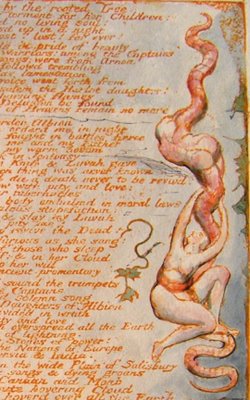
Beneath Gwendolen on the same plate, her sister Cambel is shown trying to humanize Hand. What she gets, due to her envy of Gwendolen, is a deformed infant:

After more affliction, she gives her own beauty to Hand. Unfortunately, Hand and Hyle have not themselves experienced Los's furnaces and later come back to terrorize the sisters.
Next Blake inserts an image he has used in other books, of an old man led by a child. Their goal seems to be the door to the Gothic church, on the left (Plate 84):
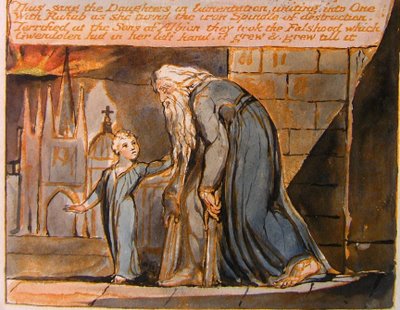
At this point Los, who previously absorbed his wife Enitharmon into his bosom, realizes that with Enitharmon in his bosom he can't really see her. He wants more than an obedient slave. So he releases her for the second time..
Plate 87 shows them on the right:

Enitharmon is the lower onereaching toward Los, who has his head turned. Blake describes their new relationship:
Los starts to grow vines, which Enitharmon takes (Plate 85):

Los has his head turned because they are arguing. He wants them woven into more sons and daughters. She replies she will weave his fibers "Not as thou wilt but as I will" (87:12-13). She plans to weave them into "a round womb beneath my bosom" (87:14). If "sons and daughters" is a metaphor for works of art, we can imagine what the issue might be between Blake and his wife. Perhaps she wants to be a part of the creative process, to be more a mother than a midwife. On the next page she is seen defying Los by "creating the Female Womb/In mild Jerusalem around the Lamb of God" (88:52-53). Her intent is to provide a womb for Jesus's rebirth.And in fact it will be just such such a visitation by the Lamb that awakens Albion to his higher purpose
In the picture, notice the Moon and the Sun in back of the two figures. Here the Moon is next to the male, and the Sun next to the female. This is opposite to their position in alchemical engravings. I think it has to do with the argument that Los and Enitharmon are having. Enitharmon says "Let man's delight be Love; but Woman's delight be Pride" (8716)--that is to say, her own pride. As if to illustrate her point, Blake's illustration shows the moon, conventionally feminine, is a symbol of love, and the sun, conventionally masculine, of pride. Los has dominated her for so long, it's time to redress the balance. Los retorts somewhat cryptically that by refusing his "fibers of dominion" (88:13) she is depriving them of Earth's greatest joy, and the key to human brotherhood. Enitharmon scornfully says that it is "Womans World" (88:16) already, meaning a world under the rule of Vala and Jerusalem; "You are Albion's victim; he has set his Daughter in your path".(87:24). In Blake's case, he wants dominion over woman, but he himself is enslaved by his muse.
In Plate 92, a woman sits up in a posture of lament; lifeless heads lie around here:

For Erdman the woman is Jerusalem, mourning her dead sons. For others, it is Enitharmon, and Jerusalem is the city in the background. The text here, "The poets song draws to its period, and Enitharmon will be no more," is Enitharmon's lament. Erdmann sees a correspondence here with Isaiah 3:25-26: "Thy men shall fall by the sword, and thy mighty in the war. And her [Jerusalem's] gates shall lament and mourn; and she being desolate shall sit upon the ground." The heads, Erdman says, are the four Zoas, Blake's embodiments of the four basic areas of vitality (from the Greek "Zoe," meaning "life"); they were laid low but are ready for resurrection. The one in front definitely looks like Urizen.
Next, we see the spectres again, the archers of the Old Testament, now unmasked as human accusers. The words are "Anytus Melitus & Lycon thought Socrates a very Pernicious Man" and "So Caiphas thought Jesus" (Plate 93)

At the bottom of the page, a female figure looks up and sees the accusers for who they are (Plate 93):
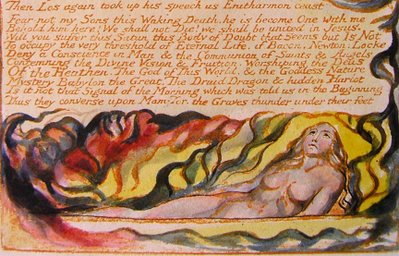
She could be Enintharmon or Jerusalem in the "furnaces of Los" (94:12), or "Erin sitting in the Tomb, to watch them unceasing night and day" (94:13). Blake hoped Ireland would stand up to her oppression.
On the next page (Plate 94), the accusers have become lifeless, their power to enslave gone:
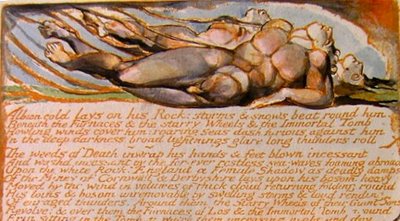
At the bottom of the same page a figure lies on Albion's lifeless body. Blake writes, "And England who is Brittannia awoke from Death on Albions bosom/ She awoke pale & cold she fainted seven times on the Body of Albion" (94:20-21; Plate 94):

According to Erdman, Brittannia is another name for Jerusalem. According to other interpreters the reason for the name-change from Jerusalem to Brittannia is that Jerusalem and Vala are now one, integrated into a single awakened being. Indeed, Britannia in her lament here cries
On the next page, Albion begins to stand up, in response to Brittannia's lament. The page begins, "Her voice pierced Albions clay cold ear, he moved upon the Rock" (95:1). Albion rises up "In anger, the wrath of God breaking bright flaming on all sides around/ His awful limbs, into the Heavens he walked clothed in flames" (95:6f).
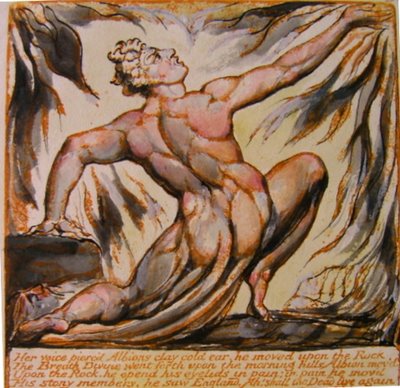
Unaccountably, Albion has a strange tail here; perhaps it is his garment falling away from him, like the "robe of the promise" in Milton, or the robe that became Urizen's "net of religion."
Albion is fully upright, touching the sun and looking toward the moon (Plate 97). Blake tells us, "The Sun & Moon lead forward the Visions of Heaven & Earth" (95:21, 96:1)

Next, "England who is Brittannia enterd Albions bosom rejoicing,/ Rejoicing in his indignation! adoring his wrathful rebuke" (95:22f). This scene appears to be what is illustrated on the next page, Plate 96.:
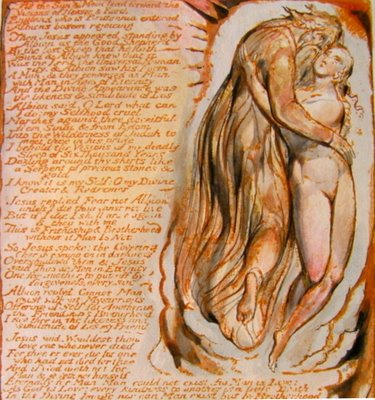
Blake adds, perhaps with reference to his own wife, "She who adores not your frowns will only loathe your smiles" (95:24). Albion, or more exactly what he is internally, in his "bosom," has the form of the wrathful old Jehovah, who rumbles his thunder and flashes his lightning in the clouds.
Later Blake will call this aged figure "the Universal Father" (97:6). But first Albion needs a lesson from Jesus, who suddenly appears in the likeness of Los. Albion despairs of being worthy of him, saying:
.
In response to Jesus's words, Albion enters the "furnaces of affliction" and self-annihilation. The furnaces become "Fountains of Living Waters flowing up from the Humanity Divine" (96:35). The Cities of Albion arise from their slumbers, and the four Zoas awake and arise into Albion's bosom. Albion stands "before Jesus in the Clouds of Heaven" (96:42f). "Awake Jerusalem!" says the "Universal Father:" within Albion, "the night of Death is past and the Eternal Day /Appears upon our Hills" (97:1-6).
Plate 97 tells us that "Albion stretched his hand into Infinitude and took his bow" (97:6f). What we see is Albion reaching toward the sun. It apparently represents "the bow in his burning hand," (95:12-13) while the "arrows of flaming gold" (95:13) are the sun's rays, as Erdmann speculates.

The bow is fourfold, one for each of the zoas. .Shot from the fourfold Bow, the "arrrows of Intellect" annihilate "the Druid Spectre" (97:7). I am reminded of the earlier spectral bowmen: It is the same energy, without the bat-wings. The accuser's energy is turned against himself.

Blake does not say whether Albion forgives his spectre's sins. One would hope that he does. As Blake will tell us shortly, the spectral triumvirate of "Bacon & Newton & Locke" have a place in Heaven. Moreover, in the last plate, number 100, Los's spectre will appear again, as we shall see. Reborn spectres can be carriers of light.
Now Chariots of the Almighty appear, carrying "Bacon & Newton & Locke, & Milton & Shakspear & Chaucer" (98:10). The spectral reasoning power is no longer hateful, when joined with imagination and feeling. Blake has more on chariots: He speaks of "The Four Living Creatures Chariots of Humanity Divine Incomprehensible." Perhaps he is referring to the Chariot of Ezekiel that we saw earlier:

The difference is that these chariots are of great splendor, their riders no longer under Vala's bewitchment.
Blake's vision continues:

In the last plate with text on it, Jerusalem and the "Universal Father" return (Plate 99; for some reason I did not find this plate at Yale; I take this image from Hamlyn and Phillips).
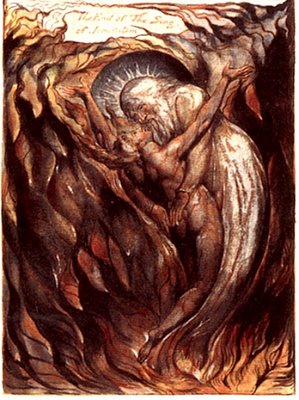
This time the young figure is more androgynous, as though representing the soul of whichever gender, or of the androgynous soul, or the soul stripped of gender. Los had declared, "Sexes must vanish & cease/ To be when Albion arises from his dread repose" (92:13f). The Universal Father here remains an old man, like the Eternals of The First Book of Urizen. The pair is surrounded by dark, reddish flames arching over them, perhaps turning into fountains at the top, but also resembling vegetation or spools of thread..
It is the "excrementitious Husk" of "the Body of Death" being driven by the flames "in an Eternal Death & Resurrection." It is the furnaces of affliction changing into the fountains of living waters. It is
The book ends with three of the formerly fallen Eternals no longer fallen, but standing erect and in the light of both sun and moon (Plate 100):
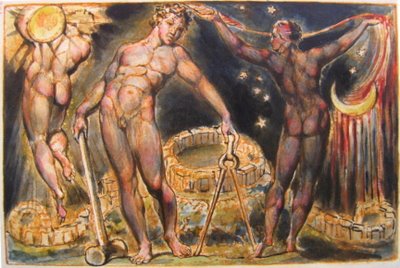
According to Erdman, Los is the one in the middle, with his hammer and compass-like tongs. Enitharmon is on our right, close to the moon. On the left, shouldering the sun, is Los's spectre, now transformed, according to Erdman and most other interpreters. The sunbeams have a little of that old bat-wing shape, Erdman argues.
However, it seems to me that the figure on the left also completes Albion's motion of grasping the sun (Plate 97) and could thus be Albion. In fact, the figures on the left and right could be all the male and female protagonists of the tale.
The female seems to be hanging red fibers on the crescent moon, presumably from the white strip above her. Perhaps this is Vala continuing to weave her veil, extending down from her moon to the earth. Blake often speaks of Vala's veil as scarlet in color, presumably the blood of fallen humanity. Thus the cycle continues, rising and falling into incarnation.
In Erdman's view, the figure is Enitharmon weaving the fibers of Los into their sons and daughters, the task she had resisted earlier (in 87:10). As Erdman puts it, the fibers are "veins of mortal life immortal," to be woven into what Blake calls elsewhere the "immortal atmospheres," the highest firmaments in the divine world. Erdman refers to Four Zoas 37:8, where Urizen's emanation Ahainia flatters Urizen by saying, "thine are the immortal atmospheres." Another reference is Jerusalem 63:40, where Albion thinks erroneously that he sees the "immortal atmospheres" behind Vala. As for the redness, Erdman cites America 4:5, where Blake envisions clouds rising from the Atlantic in vast wheels of blood, human blood "shooting its veins all round the orbed heaven." Unlike the blood of sacrificial victims, this blood is the blood of liberty.
You will notice that the fibers on the moon are not only red, but also white, the color of the stars, and of the white that appeared above the pair in Plate 98.. If red is mortality, white is immortality, the two being woven together. But is it only the sons and daughters of Los that Enitharmon is weaving? She may not have yielded to Los's will at all; she may also be satisfying her own independent desire. With those red and white strands, perhaps she is weaving a womb for the Lamb--an immortal born in the hearts of mortal men and women.
In any case, there is a rather neat correspondence between Blake's three figures here and Jung's Ego, Anima, and Shadow. Behind the three ambiguous figures of Plate 100 is a restored Druid structure, a temple of the sun and moon, the ancient glory of Britain restored and redeemed. Blake got this design from a writer on the Druids named Stuckley, who hypothesized erroneously that ruins at Avebury followed this design. Blake's backdrop is an unexpected image of the new city now complete, corresponding to the Juingian Self. Simultaneously it is a reversion to the ancient order, from which the cycle repeats.
Thus at the end of Jerusalem we are at the end of history, when time and space are no more--and also when the cycle begins again, in an eternal destruction and construction of divinity.

As he peels away the bricks, the image is that of Los "the Remover of Limits & the Resurrection of the Dead" (.73:30). It is as though the bricks were the shell of an egg, to be broken so that the spirit within may step out.
On the other hand, if he is aiming at the sun, he is alluding to an earlier stage of the process. In that case, the sun is not the spirit, but rather the "all the Kings & Nobles of the Earth & all their Glories" (73:38). It is the false barbed sun of Urizen, in other words. By pounding the kings and nobles into his furnace, he is surrounding them with the prophets, "to preserve them from Eternal Death" (73:40), a process which in the furnace succeeds in "dissipating the rocky forms of Death, by his thunderous Hammer (73:43). In either case, Blake is showing us the transforming power of Los's "furnaces of affliction.".
Another source of movement, as Jerusalem comes to a close, occurs after Gwendolen advises her sisters. Blake says, "To entice her Sisters away to Babylon...she closed her left hand and utter'd her Falsehood: Forgetting that Falsehood is prophetic, she hid her hand behind her, Upon her back behind her loins and thus utter'd her Deceit" (82:10-22). The deceit is a lie about Los, that he is plotting against them. Gwendolem hopes thereby to draw her sisters away from Los and toward Vala's Babylon. Blake has a depiction of this scene, showing a young woman's left hand behind her back talking to eleven other ladies, i.e. the other eleven daughters of Vala. But in the illustration Gwendolen is doing something with her right hand that is not in the text: she is pointing to a piece of writing in mirror-writing (Plate 81):

To read what it says, let us first make the writing horizontal:

Then if we reverse right and left in the image, we get the following:

"In Heaven the only Art of Living/ Is Forgetting & Forgiving./ Especially to the Female. But if you on Earth Forgive,/ You shall not find where to Live."
Besides the reference to Gwendolen uttering a falsehood, another thing that makes these statements suspect is that they are in the same position as Vala was in a similar scene earlier, tempting Jerusalem.
Yet the commentators insist--rightly, I think--that Blake does not mean the statement at which Gwendolen is pointing to be taken as false. The falsehood is in Gwendolen's left hand. Blake is having her right hand do something her left hand apparently does not know about. The statement about "Forgetting & Forgiving" is something Blake's Jesus could have said. Blake made this clear at the beginning of the book: "The Spirit of Jesus is continual forgiveness of Sin" (Plate 3, no line number).
But what are we to make of the other statements in the bubble: "Especially to the Female" and the one, "If you on Earth forgive, you shall not find where to live"?
"Especially to the female" might mean either "It is especially important to forgive the female" or "It is especially important that the female forgive."
For more on this issue, let us look at another Plate with aphorisms on it. At the top are two angels grieving, with a globe between them. On it are the words. "Continually Building, Coninually Decaying, because of Love and Jealousy" (Plate 72, top):

In other words, jealousy destroys what love builds up. Then at the bottom of the page is another piece of mirror-writing, which I have flipped so that it is readable (Plate 72, bottom).

"Women the Comforters of Men become the Tormenters & Punishers." Here the message is clear: women are the ones who need to forgive rather than punish. On the other hand, maybe this is the snake speaking. But why this focus on women?
Perhaps it says something about Blake's home life. Blake likely wasn't the easiest person to live with. We already know about his "foolish pride." Maybe his wife was getting upset about his foolishness. We also have had reason to suspect his jealousy, that like Los he might have tried to shut his wife up to have just for himself.
Another possibility is that at some point in his marriage his attention might have gone to another woman, even if he had not acted upon his desire. One of Blake's earliest biographers, who interviewed people who knew the couple, makes a significant comment: "There had been stormy times...when both were young; discord by no means trifling...But with the cause (jealousy on her side, not wholly unprovoked) the strife had ceased also (Gilcrest, 1863, as quoted in Bentley, The Stranger from Paradise, 2001, p. 144).
Along these lines, a few of the "Songs of Experience," which he had engraved in 1794, suggest discomfort with the marriage bond. One is "The Clod and the Pebble"

Love seeketh not Itself to please,So apparently other-devoted Love has a hidden agenda of contractual obligation.
Nor for itself has any care;
But for another gives its ease,
And builds a Heaven in Hell's despair.
So spung a Little Clod of Clay,
Trodden with the cattles feet:
But a Pebble of the brook
Warbled out these metres meet:
Love seeketh only Self to please,
To bind another in Its delight,
Joys in another's loss of ease,
And builds a Hell in Heaven's despite.
Another example is the poem "My Pretty Rose Tree":

A FLOWER was offer'd to me,
Such a flower as May never bore;
But I said, "I've a Pretty Rose-Tree,"
And I pass'd the sweet flower o'er.
Then I went to my Pretty Rose-Tree,In the illustration, in case someone did not get the metaphor, a man grieves while a woman stares straight ahead. Here the "Rose Tree" might be Blake's wife, and the "flower" another woman who attracted him. One can imagine the scene, the wife saying, "Go ahead, you don't need my permission!" and giving the husband a cold shoulder. Feeling betrayed by his faithless feelings, she distances herself from him. That would make the absence of Enitharmon from Los's bosom more autobiographical than we might have realized. And it becomes even worse if the next time the husband has these feelings, he simply acts upon them and she discovers his affair ono her own. (Janet Warner has developed this idea in her fictional biography of Catherine Blake. She adds that Catherine could also have been jealous of Blake's Platonic relationships with women who were more intellectual than she was, such as the early feminist Mary Wollenscraft.)
To tend her by day and by night;
But my Rose turn'd away with jealousy,
And her thorns were my only delight.
Whatever actually happened, Blake might have been experiencing his wife's reaction to him as punishment and torment, when what he wanted was forgiveness. Perhaps that is why he wrote this part in mirror-writing. Catherine Blake helped her husband in the printing; the words in mirror-writing would have read correctly on the plates.
For Catherine, the problem would be that it is hard to forgive some things, and to expect one simply to deny one's anger, or overcome it on one's own, is unfair. It blames the victim, when perhaps she is doing the best she can. To that extent, "Forgiving and Forgetting" is a goal to strive toward in this life, not a commandment. But if one does achieve it, one has indeed attained heaven in this life. Perhaps that is all Blake wanted to say.
But how is one to achieve such a thing with integrity? There are words at the bottom of Plate 82 that are not in mirror-writing and so presumably can be taken straight: "In Heaven Love begets Love; but Fear is the Parent of Earthly Love: and he who will not bend to love must be subdued by Fear." In other words, much of what passes for love on earth is based on fear: fear of being alone, fear of betrayal, even fear of fear. Applied to the words in the bubble, the message would seem to be that heavenly love, unlike earthly, is based only on its divine self. To be able to forgive, one must overcome fear. The problem is that fear is often realistic in this life. Why did Jesus overturn the tables of the money-lenders if not from fear--not of harm to himself, but to others? On the other hand, fear is sometimes not realistic.
All this relates to the last statement in the bubble: "If you on earth forgive,/ You will not find where to live." Sometimes this is true. Jesus apparently had no fixed address. But often it is not true. Sometimes there really isn't a good reason for fear, and it is constructive to "forgive and forget." And sometimes we just don't know. Perhaps Blake is telling us not to mix up heaven and earth, while at the same time striving to make earth as much like heaven as we can, through removing the reasons for fear and striving for mutual forgiveness. This is obviously a very hard area, for Blake and for all of us..
In Plate 81, Cambel reacts to Gwendolen by taking the classical Venus pudica pose, Venus ashamed, which the Renaissance took from Graeco-Roman sculpture. She seems to be responding to the words in the bubble rather than Gwendolen's "falsehood." She and some of the other daughters of Albion actually do submit to Los's "furnaces of affliction," despite Gwendolen's lie.
Blake uses the image of the worm to show the transformation in visual terms. (The art is on Plate 80, although it actually does not happen in the text until Plate 82.) On the top of the page, Gwendolen, inspired by the example of her sister Cambel, is shown humanizing Hyle, her lover, by the force of her love:

Beneath Gwendolen on the same plate, her sister Cambel is shown trying to humanize Hand. What she gets, due to her envy of Gwendolen, is a deformed infant:

After more affliction, she gives her own beauty to Hand. Unfortunately, Hand and Hyle have not themselves experienced Los's furnaces and later come back to terrorize the sisters.
Next Blake inserts an image he has used in other books, of an old man led by a child. Their goal seems to be the door to the Gothic church, on the left (Plate 84):

At this point Los, who previously absorbed his wife Enitharmon into his bosom, realizes that with Enitharmon in his bosom he can't really see her. He wants more than an obedient slave. So he releases her for the second time..
Plate 87 shows them on the right:

Enitharmon is the lower onereaching toward Los, who has his head turned. Blake describes their new relationship:
Two Wills they had; Two Intellects: & not as in times of old.But Los's face is already turned away. The figure in the upper left might be Los's spectre, looking down at Los and Enitharmon and "knowing himself the author of their divisions" (88:34-35). Or it could be their father, Thamos, the spirit of sexuality, looking down in alarm or anger. In the center is Enion, the mother of Los and Enitharmon, now "blind and age-bent," as the line just below the picture indicates. She is clutching at Enitharmon, who steps away. Erdman says that the figure on the lower left is Erin, who represents Ireland; Blake says she watches in "eternal tears" (86:43). She is still under the spectre's domination
Silent they wandered hand in hand like two Infants wandring
From Enion in the desarts, terrified of each others beauty
Envying each other yet desiring, in all devouring Love. (86:61-64).
Los starts to grow vines, which Enitharmon takes (Plate 85):

Los has his head turned because they are arguing. He wants them woven into more sons and daughters. She replies she will weave his fibers "Not as thou wilt but as I will" (87:12-13). She plans to weave them into "a round womb beneath my bosom" (87:14). If "sons and daughters" is a metaphor for works of art, we can imagine what the issue might be between Blake and his wife. Perhaps she wants to be a part of the creative process, to be more a mother than a midwife. On the next page she is seen defying Los by "creating the Female Womb/In mild Jerusalem around the Lamb of God" (88:52-53). Her intent is to provide a womb for Jesus's rebirth.And in fact it will be just such such a visitation by the Lamb that awakens Albion to his higher purpose
In the picture, notice the Moon and the Sun in back of the two figures. Here the Moon is next to the male, and the Sun next to the female. This is opposite to their position in alchemical engravings. I think it has to do with the argument that Los and Enitharmon are having. Enitharmon says "Let man's delight be Love; but Woman's delight be Pride" (8716)--that is to say, her own pride. As if to illustrate her point, Blake's illustration shows the moon, conventionally feminine, is a symbol of love, and the sun, conventionally masculine, of pride. Los has dominated her for so long, it's time to redress the balance. Los retorts somewhat cryptically that by refusing his "fibers of dominion" (88:13) she is depriving them of Earth's greatest joy, and the key to human brotherhood. Enitharmon scornfully says that it is "Womans World" (88:16) already, meaning a world under the rule of Vala and Jerusalem; "You are Albion's victim; he has set his Daughter in your path".(87:24). In Blake's case, he wants dominion over woman, but he himself is enslaved by his muse.
In Plate 92, a woman sits up in a posture of lament; lifeless heads lie around here:

For Erdman the woman is Jerusalem, mourning her dead sons. For others, it is Enitharmon, and Jerusalem is the city in the background. The text here, "The poets song draws to its period, and Enitharmon will be no more," is Enitharmon's lament. Erdmann sees a correspondence here with Isaiah 3:25-26: "Thy men shall fall by the sword, and thy mighty in the war. And her [Jerusalem's] gates shall lament and mourn; and she being desolate shall sit upon the ground." The heads, Erdman says, are the four Zoas, Blake's embodiments of the four basic areas of vitality (from the Greek "Zoe," meaning "life"); they were laid low but are ready for resurrection. The one in front definitely looks like Urizen.
Next, we see the spectres again, the archers of the Old Testament, now unmasked as human accusers. The words are "Anytus Melitus & Lycon thought Socrates a very Pernicious Man" and "So Caiphas thought Jesus" (Plate 93)

At the bottom of the page, a female figure looks up and sees the accusers for who they are (Plate 93):

She could be Enintharmon or Jerusalem in the "furnaces of Los" (94:12), or "Erin sitting in the Tomb, to watch them unceasing night and day" (94:13). Blake hoped Ireland would stand up to her oppression.
On the next page (Plate 94), the accusers have become lifeless, their power to enslave gone:

At the bottom of the same page a figure lies on Albion's lifeless body. Blake writes, "And England who is Brittannia awoke from Death on Albions bosom/ She awoke pale & cold she fainted seven times on the Body of Albion" (94:20-21; Plate 94):

According to Erdman, Brittannia is another name for Jerusalem. According to other interpreters the reason for the name-change from Jerusalem to Brittannia is that Jerusalem and Vala are now one, integrated into a single awakened being. Indeed, Britannia in her lament here cries
"In dreams of Chastity & Moral Law I have Murdered Albion!This is Vala speaking, Albion's wife.But what is she jealous about? Vala explained earlier (80:16) that she had murdered Albion by keeping him embalmed "in moral laws" (80:27) and "spices of sweet odours of lovely jealous supefaction" (80:28) after his fall. She was fearful of what he might do if he regained his former power. So apparently she was jealous of his power. Another thing she could be jealous of is Albion's attachment to his daughter Jerusalem. Now that she is at one with Jerusalem, she asks for forgiveness.
In Stonehenge & on London Stone & in the Oak Groves of Mlen
I have Slain him in my Sleep with the Knife of the Druid O England
O all ye Nations of the Earth behold ye the Jealous Wife..." (94:23-26)
On the next page, Albion begins to stand up, in response to Brittannia's lament. The page begins, "Her voice pierced Albions clay cold ear, he moved upon the Rock" (95:1). Albion rises up "In anger, the wrath of God breaking bright flaming on all sides around/ His awful limbs, into the Heavens he walked clothed in flames" (95:6f).

Unaccountably, Albion has a strange tail here; perhaps it is his garment falling away from him, like the "robe of the promise" in Milton, or the robe that became Urizen's "net of religion."
Albion is fully upright, touching the sun and looking toward the moon (Plate 97). Blake tells us, "The Sun & Moon lead forward the Visions of Heaven & Earth" (95:21, 96:1)

Next, "England who is Brittannia enterd Albions bosom rejoicing,/ Rejoicing in his indignation! adoring his wrathful rebuke" (95:22f). This scene appears to be what is illustrated on the next page, Plate 96.:

Blake adds, perhaps with reference to his own wife, "She who adores not your frowns will only loathe your smiles" (95:24). Albion, or more exactly what he is internally, in his "bosom," has the form of the wrathful old Jehovah, who rumbles his thunder and flashes his lightning in the clouds.
Later Blake will call this aged figure "the Universal Father" (97:6). But first Albion needs a lesson from Jesus, who suddenly appears in the likeness of Los. Albion despairs of being worthy of him, saying:
"...My Selfhood cruelJesus replies:
Marches against thee deceitful." (96:8-9)
"Fear not Albion, unless I die thou canst not live,Albion asks:
But if I die I shall arise again and thou with me." (96:14-15)
"Cannot Man exist without Mysterious Offering of Self for Another?" (96:20-21)Jesus replies:
"Wouldest thou love one who never diedThis last sentence is the point: In every selfless kindness, in every forgiveness of sins against one, the Selfhood dies and is reborn as the Divine Image. This is true even though one also lives in the world of the fallen, where it is also true that "If you on Earth Forgive,/ You shall not find where to Live." Human life is in the tension between these two poles.
For thee or ever die for one who had not died for thee?
And if God dieth not for Man & giveth not himself
Eternally for Man Man could not exist. for Man is Love:
As God is Love: every kindness is a little death
In the Divine Image nor can Man exist but by Brotherhood" (96:23-28)
.
In response to Jesus's words, Albion enters the "furnaces of affliction" and self-annihilation. The furnaces become "Fountains of Living Waters flowing up from the Humanity Divine" (96:35). The Cities of Albion arise from their slumbers, and the four Zoas awake and arise into Albion's bosom. Albion stands "before Jesus in the Clouds of Heaven" (96:42f). "Awake Jerusalem!" says the "Universal Father:" within Albion, "the night of Death is past and the Eternal Day /Appears upon our Hills" (97:1-6).
Plate 97 tells us that "Albion stretched his hand into Infinitude and took his bow" (97:6f). What we see is Albion reaching toward the sun. It apparently represents "the bow in his burning hand," (95:12-13) while the "arrows of flaming gold" (95:13) are the sun's rays, as Erdmann speculates.

The bow is fourfold, one for each of the zoas. .Shot from the fourfold Bow, the "arrrows of Intellect" annihilate "the Druid Spectre" (97:7). I am reminded of the earlier spectral bowmen: It is the same energy, without the bat-wings. The accuser's energy is turned against himself.

Blake does not say whether Albion forgives his spectre's sins. One would hope that he does. As Blake will tell us shortly, the spectral triumvirate of "Bacon & Newton & Locke" have a place in Heaven. Moreover, in the last plate, number 100, Los's spectre will appear again, as we shall see. Reborn spectres can be carriers of light.
Now Chariots of the Almighty appear, carrying "Bacon & Newton & Locke, & Milton & Shakspear & Chaucer" (98:10). The spectral reasoning power is no longer hateful, when joined with imagination and feeling. Blake has more on chariots: He speaks of "The Four Living Creatures Chariots of Humanity Divine Incomprehensible." Perhaps he is referring to the Chariot of Ezekiel that we saw earlier:

The difference is that these chariots are of great splendor, their riders no longer under Vala's bewitchment.
Blake's vision continues:
Living Creatures starry & flamingAll creatures rejoice (Plate 98):
With every Colour, Lion, Tyger, Horse, Elephant, Eagle Dove, Fly, Worm,
And the all Wondrous Serpent clothed in gems & rich arrray Humanize
In the forgiveness of Sins according to the Covenant of Jehovah. (98:42-45)

In the last plate with text on it, Jerusalem and the "Universal Father" return (Plate 99; for some reason I did not find this plate at Yale; I take this image from Hamlyn and Phillips).

This time the young figure is more androgynous, as though representing the soul of whichever gender, or of the androgynous soul, or the soul stripped of gender. Los had declared, "Sexes must vanish & cease/ To be when Albion arises from his dread repose" (92:13f). The Universal Father here remains an old man, like the Eternals of The First Book of Urizen. The pair is surrounded by dark, reddish flames arching over them, perhaps turning into fountains at the top, but also resembling vegetation or spools of thread..
It is the "excrementitious Husk" of "the Body of Death" being driven by the flames "in an Eternal Death & Resurrection." It is the furnaces of affliction changing into the fountains of living waters. It is
...all human forms identified living going forth & returning weariedThe purified soul is leaving mortality, but also returning to it, to dwell in the human heart.
Into the Planetary lives of Years Months Days & Hours reposing
And then Awaking into his Bosom in the Life of Immortality (99:1-4)
The book ends with three of the formerly fallen Eternals no longer fallen, but standing erect and in the light of both sun and moon (Plate 100):

According to Erdman, Los is the one in the middle, with his hammer and compass-like tongs. Enitharmon is on our right, close to the moon. On the left, shouldering the sun, is Los's spectre, now transformed, according to Erdman and most other interpreters. The sunbeams have a little of that old bat-wing shape, Erdman argues.
However, it seems to me that the figure on the left also completes Albion's motion of grasping the sun (Plate 97) and could thus be Albion. In fact, the figures on the left and right could be all the male and female protagonists of the tale.
The female seems to be hanging red fibers on the crescent moon, presumably from the white strip above her. Perhaps this is Vala continuing to weave her veil, extending down from her moon to the earth. Blake often speaks of Vala's veil as scarlet in color, presumably the blood of fallen humanity. Thus the cycle continues, rising and falling into incarnation.
In Erdman's view, the figure is Enitharmon weaving the fibers of Los into their sons and daughters, the task she had resisted earlier (in 87:10). As Erdman puts it, the fibers are "veins of mortal life immortal," to be woven into what Blake calls elsewhere the "immortal atmospheres," the highest firmaments in the divine world. Erdman refers to Four Zoas 37:8, where Urizen's emanation Ahainia flatters Urizen by saying, "thine are the immortal atmospheres." Another reference is Jerusalem 63:40, where Albion thinks erroneously that he sees the "immortal atmospheres" behind Vala. As for the redness, Erdman cites America 4:5, where Blake envisions clouds rising from the Atlantic in vast wheels of blood, human blood "shooting its veins all round the orbed heaven." Unlike the blood of sacrificial victims, this blood is the blood of liberty.
You will notice that the fibers on the moon are not only red, but also white, the color of the stars, and of the white that appeared above the pair in Plate 98.. If red is mortality, white is immortality, the two being woven together. But is it only the sons and daughters of Los that Enitharmon is weaving? She may not have yielded to Los's will at all; she may also be satisfying her own independent desire. With those red and white strands, perhaps she is weaving a womb for the Lamb--an immortal born in the hearts of mortal men and women.
In any case, there is a rather neat correspondence between Blake's three figures here and Jung's Ego, Anima, and Shadow. Behind the three ambiguous figures of Plate 100 is a restored Druid structure, a temple of the sun and moon, the ancient glory of Britain restored and redeemed. Blake got this design from a writer on the Druids named Stuckley, who hypothesized erroneously that ruins at Avebury followed this design. Blake's backdrop is an unexpected image of the new city now complete, corresponding to the Juingian Self. Simultaneously it is a reversion to the ancient order, from which the cycle repeats.
Thus at the end of Jerusalem we are at the end of history, when time and space are no more--and also when the cycle begins again, in an eternal destruction and construction of divinity.

0 Comments:
Post a Comment
<< Home